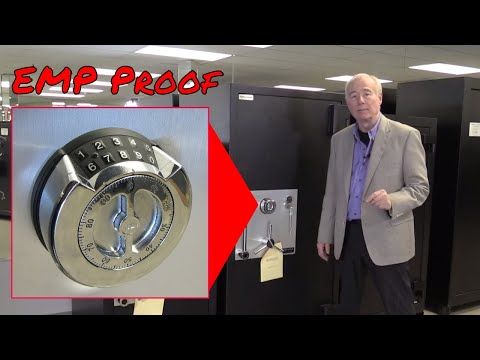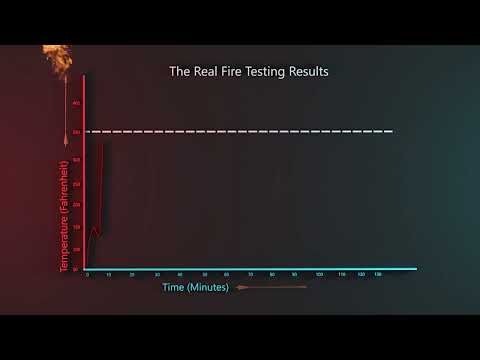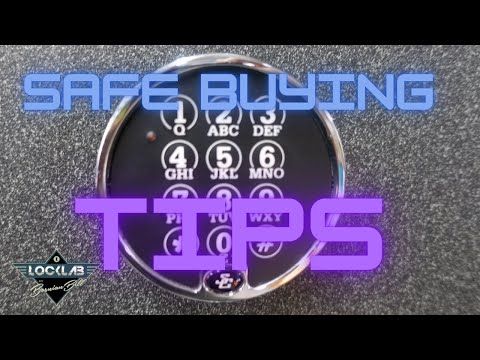Buying a Gun Safe for the first time can be a process. Similar to buying a car, it takes quite a bit of research for what seems like just a hunk of metal. Add in conflicting information from manufacturers and it quickly becomes even more confusing. But, have no fear! I’m here to help simplify the process and provide some excellent tips for where to shop, what to look for and how to decide which safe is right for you in these 6 Gun Safe buying tips for first time buyers.
Tip #1: Make Sure the Safe has a UL Rated Lock
The lock is the most important feature of any gun safe. It’s like the engine to the car and when the engine goes bad, it can be extremely expensive to fix or replace. In the safe world, there are two types of lock categories. There are locks that are tested by Underwriters Laboratories, UL for short, and those that are not. It is critically important to buy a safe with a UL rated lock not only for the security but the long term reliability. The cheap safes you find at Costco, Walmart and Tractor Supply will NOT have UL rated locks, they instead use an extremely cheap Solenoid lock that has multiple security vulnerabilities and a key override so that you can still get into the safe when the lock inevitably fails. These locks are near impossible to replace when they go bad and do not have the same mounting footprint as the standard UL rated locks. It may seem like a good deal when you buy it, but if it needs a locksmith to open it for $400 a couple years later, it’s not worth the savings today. Solenoid locks will not have a brand and manufacturers will say as little as possible about them in the listing descriptions. Make sure the safe you buy says UL Approved High Security Lock in the listing.

UL Approved Type 1 Electronic Locks
Now, when it comes to UL rated locks there are two kinds. The first is UL Approved Type 1 which covers of all of the electronic locks. Electronic locks are considered the highest security rating as they have over 1 million possible combinations and can not be manipulated through a dial. The keypad you see on the outside of the safe is just like a keyboard that connects to a computer and the computer is the lock on the inside of the safe. These locks are built in hardened steel enclosures and are extremely tough to drill through, even when you know exactly where to drill. The locks are often offset from the small hole required for the cord that runs to the keypad which eliminates someone from just sticking a punch in the hole and hammering away until the lock breaks off. There are three major lock brands that produce high quality UL approved electronic locks and they are NL, SecuRam and S&G (Sargent & Greenleaf). I recommend you purchase a safe with a UL rated electronic lock from one of these brands. All three of these brands keep the battery in the keypad outside the safe so that if the battery dies, you can easily replace it and get right back into your safe.


UL Approved Type 2 Mechanical Locks
The Second type of UL rated lock is UL Approved Type 2 which covers all Mechanical Locks. Mechanical locks are like your high school gym locker that uses a turn wheel with a 3 or 4 number combination. These are the traditional “old school” locks with no batteries or electronics and are considered the most reliable over the long term. They are ranked second in terms of security due to their ability to be manipulated by expert safe crackers. Your average thief will still not be able to manipulate this type of lock and overall they are good quality. I would only recommend Mechanical locks made by S&G or Big Red as they have been around for decades and have high quality reviews and long term reliability.


UL Approved Redundant Locks
The last type of UL rated lock is the NL and SecuRam Redundant Locks. These locks are incredibly unique in that they feature both electronic access with mechanical backup. The biggest complaint people have with electronic locks is that there is no backup. If your lock malfunctions, you have to pay a locksmith (or the manufacturer will if it is covered under warranty) upwards of $400-$600 to get your safe open and then you need to purchase a new lock to replace it. With a redundant lock, you can still access your safe via the mechanical portion. With NL they place the electronics on the top of the keypad and the mechanical portion in the middle and with SecuRam, they place the electronics in the middle and the mechanical portion just like the traditional style on the top. Both locks are extremely high quality and reliable long term with the highest Type 1 Security rating, same as standard UL rated electronic locks.

Tip #2: Make Sure the Safe has a Burglary Rating
If I was selling you a car and I told you that this is the safest car ever and no one has ever died in a crash or ever will die in a crash but I had absolutely no proof whatsoever, would you believe me? You probably wouldn’t. So why then would you believe a company who says their safes are extremely tough, rugged, pick-proof and break-in proof but then don’t have them tested by an independent agency? In the safe world, Underwriters Laboratories, UL, the same testing agency that certifies the locks also tests the burglary capabilities of safes and have split them up into classifications based on how long they can survive a break-in attempt. When you buy a safe, you are buying time and the higher the rating, the more time your safe can survive a break-in attempt. The most common burglary ratings seen are RSC Level 1, RSC Level 2 and TL rated.
RSC Level 1 Burglary Rating
The most commonly found burglary rating on safes is RSC level 1 which stands for Residential Security Container. Nearly every gun safe on the market is RSC level 1 from the Stealth UL series all the way up to the Fort Knox Legend gun safes and I would strongly advise you avoid anything less than this rating such as CA DOJ Firearm Safety Device. That rating is reserved for handgun safes and is not meant to be a bragging point for gun safes and home safes. The RSC test includes hammers, chisels, adjustable wrenches, pry bars, punches and screwdrivers. The hammers are not to exceed 3 pounds in head weight and no tool is to exceed 18 inches in length. The safe must survive an attack time of at least 5 minutes with each tool and the test is conducted on only the safes door. This rating ensures you have the most basic protection against tools an average thief would commonly use.

RSC Level 2 Burglary Rating
The next level of security lies in the RSC Level 2 Burglary Rating. To the best of my knowledge, only the American Security BFII gun safes hold this rating and wow are they an absolute beast of a safe. This test adds an additional person so two people will be attacking the safe and for double the time. In this test, only the door must successfully resist being broken into for a net time of 10 minutes when attacked by all of the same tools in the RSC level 1 test plus electrical hand tools like drilling. There is even one more rating above level 2 and I’m sure you can guess what it is… yep RSC Level 3. Currently there are no safes that are RSC level 3 because it is essentially the same test as TL-15 which I will cover next.

TL Burglary Rating
Sitting at the top of the burglary ratings are the TL rated tests. This includes TL-15, TL-30 and TL-30X6. American Security is the only USA manufacturer to produce TL rated safes and they have all three. This test significantly beefs up the requirements and tools used including all of the same tools as the previous tests but then adding grinding points, carbide drills and pressure applying devices or mechanisms. The opening from the test can not exceed a 6 square inch area. Body walls of material must be equivalent to at least 1″ open hearth steel and the walls must be fastened in a manner equivalent to a 1/4″ penetration weld. A TL-15 Rating means the door survived for at least 15 minutes per tool, TL-30 bumps that up to 30 minutes and a TL-30X6 rating equals a 30 minute test on all six sides of the safe.

Tip #3: Check for an Independently Tested Fire Rating
Just like a cars crash rating in the burglary rating explanation above, if I just told you to trust me that this safe can survive a fire, I would hope you wouldn’t just believe me at my word for it. Fires can be devastating and we use safes to protect our most valuable possessions like pictures and family heirlooms not only from burglary but also from fire. Currently there are two independent agencies that test fire ratings, the first one is the same company that tests the lock and burglary capabilities, UL, and the second is Interkek also known as ETL. Nearly every single safe today comes up with their fire ratings based on a factory test. That means they put it through a fire in their factory but don’t offer any proof, pictures, videos or evidence that the safe can actually survive the fire. As they add more fireboard, they increase the rating but in the real world it doesn’t actually work like that. That’s why we need a real life simulated test to prove that the safe can actually survive and there is only one company who actually took the time and paid the money to certify the ratings. You probably already guessed it, it’s once again American Security.
ETL Verified Fire Rating
ETL has been conducting performance and reliability tests since 1896. They are internationally recognized with laboratories in over 14 counties and are the leading independent lab for gun safe fire testing. ETL uses a variety of sensors and simulates what an actual fire is like to verify a safes claimed fire rating. Paper chars at 450 degrees so safes must maintain an internal temperature of less than 350 degrees during these tests. A true fire test should show that within 8 minutes the furnace temperature was raised to 1200 degrees and that temperature must be maintained for the entire test. American Security is the only safe company that verifies their fire ratings with ETL.

UL Verified Fire Rating
UL takes the ETL fire testing to another level. There are two ratings, Class 350 1 hour and Class 350 2 hour, where the safe must maintain an interior temperature of less than 350 degrees for a period of one hour at 1700 degrees or for a period of two hours at 1850 degrees respectively. Then the safe must successfully undergo all of the other requirements for the endurance test, explosion hazard test and impact test. The endurance test is pretty much the same as the ETL test but with higher temperatures and longer periods of time. The explosion hazard test places the safe in a furnace preheated to 2000 degrees for 30 minutes (45 minutes on the 2 hour test) and if no explosion results, the safe is allowed to cool and then it is examined for usability. There may be no visible evidence of undue heat transmission inside the safe. Finally, the impact test drops the safe 30 feet onto a heavy concrete base two minutes after the explosion hazard test and if the safe can survive all three tests, it earns the UL rating. Due to a gun safes unique tall and top heavy construction, no gun safe has ever passed the UL fire test. It is mainly reserved for home safes and smaller cube shaped safes. Both American Security and Gardall offer UL fire rated safes.

Tip #4: Check and Fully Understand the Warranty
If things go wrong with your safe, you will definitely want to know what kind of warranty you have. Nearly every manufacturer offers and heavily advertises a “lifetime warranty” but what does that warranty actually mean. For nearly every single manufacturer that is a limited lifetime warranty that only repairs or replaces the safe if it goes through a break-in, attempted break-in or fire. It DOES NOT cover the lock, the safes construction or the interior. The product warranty varies greatly among all manufacturers with the minimum usually around 1 year and the max being lifetime. Another factor to consider is that just because it has a comprehensive lifetime warranty, it may be nearly impossible to get any follow through from the customer service department at the company. This is the biggest complaint with safes by the company Sports Afield. They offer a comprehensive lifetime warranty that covers all parts of the safe but what they don’t tell you is that they will never answer the phone, actually ship your replacement parts or help you whatsoever. Dean Safe Company put together an excellent comprehensive list of all of the most commonly asked warranty questions and what each major brand actually covers and pays for. Here is the link to the list: https://www.deansafe.com/pages/warranty-information. I highly recommend researching in great detail, exactly what the company will cover and what they will not so that you do not have to figure all this out when you are locked out of your safe and need your passport to go on a trip.

Tip #5: Always Buy Bigger Than You Think You Need
The #1 complaint I have heard over my 30 years of experience in the safe industry is customers telling me they wish they had bought a bigger safe. When people shop for a safe, they expect it to last a lifetime. It’s a one time purchase and something you want to get right the first time. Similar to a car, a safe does not retain its value once used and have you ever seen anyone ever sell a safe before? It’s not very common because they are extremely difficult to move once in place. When most people shop they think about how many things they have right now that they want to put in the safe but not about how many things they will have in the future that will also be placed in the safe. This is especially true of gun owners who buy more and more guns and then eventually have to buy a second or third safe. Buy as big as you can and save yourself the hassle of needing to sell your current safe or buy another one.
Another important note to consider is that when a gun safe says it can hold 44 long guns, you can typically cut that in half. The gun capacity is based on how many gun slots the safe has, not how many actually fit. Once you add magazines, optics and any other accessories to your long guns, that number gets cut even lower. That number is also usually indicative of both sides of the safe being used to store guns but are often advertised with the adjustable side shelves on one side of the gun rack.

Tip #6: Buy from a Reputable Dealer
Even though this is Tip #6, I can’t stress this one enough. With the explosion of the internet, there are so many fly by night, dropship only safe dealers that will very likely not stand the test of time. They don’t have physical store fronts, they don’t inventory any of the products and they only ship direct from manufacturer. They truly don’t even know anything about what they are selling and are just looking to make a quick buck. They may offer discounts to lure you in and often have fake reviews all over their website. Buying from a reputable dealer gives you the peace of mind that you have someone you can call if anything goes wrong. Sometimes safes are damaged in transit, sometimes you need to return it, sometimes things go wrong down the line and the manufacturer is not being very helpful. This is where a reputable dealer comes in, they can act as the liaison between the manufacturer and you, helping you get the service or warranty promised.
Reputable online safe dealers in alphabetical order include:
- Dean Safe – www.deansafe.com
- GunSafes.com – www.gunsafes.com
- Maximum Security – www.maximumsecurity.com
- Nevada Safes – www.nevadasafes.com
- NorthWest Safe – www.nwsafe.com
- Safe and Vault Store – www.safeandvaultstore.com
- The Safe Keeper – www.thesafekeeper.com
- Utah Safe Company – www.utahsafeco.com
Dropship only safe dealers to be wary of in alphabetical order include:
- Armadillo Safes – www.armadillosafes.com
- Gun Safes Now – www.gunsafesnow.com
- Safes ETC – www.safesetc.com
- USA Safe and Vault – www.usasafeandvault.com








